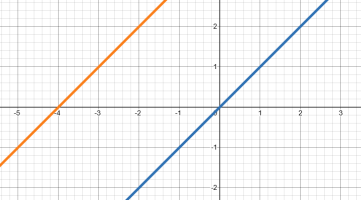logistic_guy
Senior Member
- Joined
- Apr 17, 2024
- Messages
- 2,214
Graph the function and its parent function. Then describe the transformation.
\(\displaystyle g(x) = x + 4\)
\(\displaystyle g(x) = x + 4\)
What you did was shifting the parent function up by \(\displaystyle 4\).[imath]g(x) = f(x) + 4[/imath]. f shifted leftward by [imath]4[/imath]
This is the graph of the function \(\displaystyle \textcolor{darkorange}{g(x) = f(x + 4) = x + 4}\) and its parent function \(\displaystyle \textcolor{blue}{f(x) = x}\).Graph the function and its parent function. Then describe the transformation.
\(\displaystyle g(x) = x + 4\)

